
|   |

|   |
 e-mail: leelakaverivenkat@gmail.com Konark Festival beckons again Photos courtesy: Odisha Tourism December 15, 2016 With the magnificent tower of the historic 13th century temple of the Ganga King Narasingha Deva dedicated to the Sun God as backdrop, the elaborately decorated open air auditorium at Konark (with the road leading to it showcasing the aesthetics of hand crafted lanterns, tomba-s and colourful Pipli umbrellas hung upside down, not to speak of the intricacy of the Rangoli patterns on the floor), once again became the venue for showcasing group productions of Odissi along with other pan-Indian classical dance forms. The Odisha Tourism department has over the years added attractions like the Sand Art Festival at the nearby Chandrabhaga Beach and a Handloom and Handicrafts festival - all built round the main dance event, enhancing the tourist's interest. Spacing for the audience has been neatly expanded. Another fine improvement was in the Sand Art arena with artists given independent slots near the sea with its rippling waves and plying boats, with the entire walk from exhibit to exhibit carpeted, and the visitor spared the cumbersome ploughing through mounds of sand. Given its glorious sunrise behind the sea, and attractions of hawkers selling their ware, Chandrabhaga beach was a daily crowd puller. Madhavi Mudgal and group flagged off the festival with an apt curtain-raiser in the invocation to Sun God for his life bestowing energy, Madhavi's dance composition inspired by a textual / phonetic contribution of Soumya Ranjan Mohanty, with the music provided by Madhup Mudgal. Again Madhup's musical scaffolding set the dance tone for Vasant based on Kalidas's Ritu Samhara verses, portraying the advent of Spring, ushering in the quivering, reenergized beauty of Nature and her creatures. Known for her restrained aesthetics and the polish of well trained disciples, Madhavi's reposeful productions are not given to high dramatics. The joy of Madhurashtakam, for example, substantiating the honeyed qualities of every facet of Krishna, could have had more exuberant expression. The best of the recital was the Vadya Vaividhya creation, built around percussion instruments characterized by varying tonal qualities - the rhythm and its metre evoked from each, very distinctive whether mardal, mridangam, khol or jhol. The misram, khandam, chatusram, tisram combinations and rhythmic metres with their typical accenting, emerging from each instrument, were translated in the choreography into myriad nritta combinations and neat formations. The female/male singing voices were not matching - changeovers when one stopped for the other to take over not seamless. The finale, in a speedy moksha like conclusion, was well executed. The best part of Jaishore Mosalikanti's Kuchipudi presentation was the finely balanced musical team. G. Srikant's melodious voice, Adit Narayanan's punch-filled clarity of nattuvangam, Muthukumar's flute interventions and Eshwar Ramakrishnan's mridangam percussion, provided an excellent take off point for the dance. While one had no quarrels with the choice of items, choreography and general dance quality of the male and female performers pertaining to varying heights and girths, the recital got little or no help from the light expert who seemed to have gone to sleep. Costume aesthetics one felt could have opted for less ornamentation - the television coverage was not flattering to what was a well worked out recital. Fashioned on three manifestations of female divinity, the recital beginning with a prayer to Saraswati through the "Yakundendu tushara hara dhavala..." verse set to raga Valaji was followed by Muthuswamy Dikshitar's kriti in Arabhi "Sree Saraswati Namostute." The dancing on the rim of the brass plate (Tarangam) concluded with a final prayer as an ode in ragamalika, Jaya Jaya Durge. From Keerawani to Punnagavarali, a long line of ragas accompanied the blended nritta/abhinaya number with Mosalikanti performing a duet with his wife. The "Sree Yudbhavam" finale saw the emergence of the last of the female divinity trinity Lakshmi from the ocean churned by the Gods and the Asuras for the nectar of immortality. This segment was marked by a Pravesha Daruvu, a composition of Dr. Pappu Venugopal Rao, wherein the Goddess making an entry introduces herself. 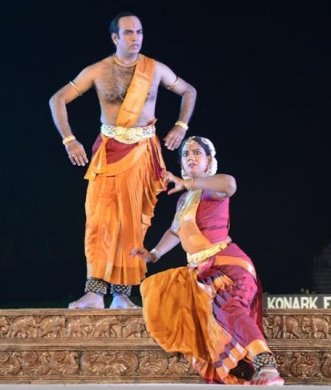 Jaishore Mosalikanti & Padmavani 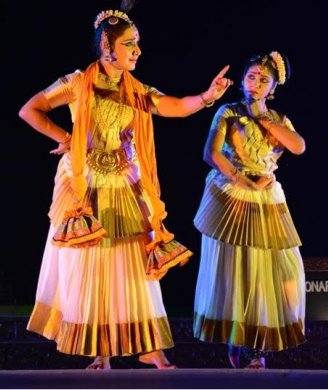 Neena Prasad & group With her traditionally prescribed white and gold costuming elegance, the Mohiniattam dancer - in this case Neena Prasad and her group could not be faulted for lack of taste. Again what an asset singer Madhavan Namboodiri is with his voice and classicism! Along with Ramesh Babu's mridangam support and edakka by Nikhil Krishnan, instrumentalists Eshwar Ramakrishnan (violin), Murali Krishnan (veena), Akhila Srichitran (nattuvangam), the melodic support left little to be desired. Well trained, the group's starting Cholkettu nritta, with music set to raga Hamsadhwani and khanda jati triputa taal, concluded on a note of thanksgiving to the Guru. Maharaja Swati Tirunal's Stava Varnam in imperial Shankarabharanam, in Neena's choreography became an interesting rhythm/ mime blend, the dramatic narration based on less well known episodes surrounding Rama - who discreetly eradicates the ego of archery experts Arjuna and Hanuman, who realize their expertise paling in comparison to Rama's prowess. The next segment of the varnam portrayed a humbled Manmatha on seeing Rama, the very epitome of beauty - a quality he regarded as his main virtue. The interspersed jatis, knitting together the sahitya, with the changing accenting came as crisp rhythmic interventions. From Parijatapaharanam came a fine piece of interactive abhinaya, wherein Rukmini as the virahini, expresses her unrequited love pangs (music in Ranjani) while Krishna (Neena) declares his love by his gesture of presenting the Parijatha sapling to Rukmini (music set to Hameer Kalyani). After the prolonged slow-paced mesmerism of Mohiniattam, the Tilang Tillana finish could have afforded increased laya - instead it tended to drag. Inspired by the Pahandi Bije of Lord Jagannath in Rath Jatra, Meera Das and group with the high vaulting rhythm of Ghanta, drums and pipes, presented a vivacious invocation to the Odissi recital. Konark Pratima with its theme of the sculpted dancer on the Konarak temple walls coming alive to dance to multifarious rhythm patterns is not a new theme. But with mardal players Dhaneswar Swain and Sachidananda Das's rhythmic creations, Meera's group acquitted itself well to her visualization of dancing Kanyas, with the bina, benu, mardal, manjira holding postures, presenting tala, and movement dictated by the central chauka and tribhanga concerns of Odissi. Some Bandha Nrutya with its acrobatic postures added spice to the composition. The finale was a dance drama Jeebana Sangeeta based on Baikuntha Nath Patnaik's (celebrated singer Sunanda Patnaik's father, and not an 18th century poet as wrongly announced by the compere) famous poem Yatra Sangeeta. With Kedar Mishra's help in crystallizing the thematic frame, Srinivas Satpathy's music and Sachidananda Das's rhythmic inputs, this work had a variety in the music with the combined singing voices of Nazia Alam and Rupak Kumar Parida providing suitable melody, barring the Meera composition (Mere, to Giridhar Gopala doosrana na koi) which Nazia needs to familiarize herself with more, to avoid flat notes. Through the brief narratives on Ahalya, or Meera who shakes off the rich shackles of royalty to which she is born and wed, to become one with Krishna (the two figures one behind the other merging into one, very well shown), the dance drama emphasized the main burden of the theme of unrelenting faith in Krishna, the "Jeevan Patra" to free the mind and let it soar in ecstasy like the bird in the sky. While one did not spot any outstanding dancer in the group, that Meera running Gunjan Dance Centre has groomed youngsters to carry off a group item with panache, is creditable indeed. 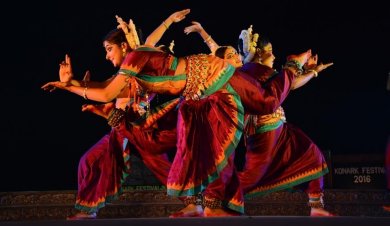 Meera Das & group 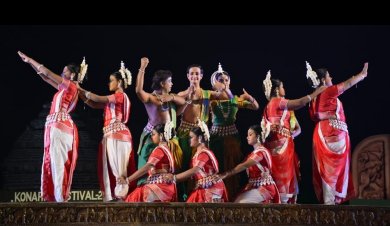 Jyotsna Sahu & group The third evening again started with Vaishnav devotional poetry in the work of Surmandir Dance Company's group presentation led by Odissi dancer Jyotsna Sahu, the production 'Sriranga Charana' based on Bijay Mallya's textual , the libretto stringing really well known pieces from hoary Odiya literature paying obeisance, at the divine feet of the Lord. The main feature was the underlying rasa, the work carried of Odiya identity - the cultural scent of the regional soil, with typical poetic bits sung in traditional metres and tunes. Jyotsna's choreography reveled in several myths, of the God coming to the rescue of the bhakta like Vamanavatar, the Ahalya episode, Kaliyamardan. The best of the narratives for this critic was the Kevat Prasang encounter with Vipanchi Das as boatman giving the character the convincing touch of unsophisticated rustic simplicity, and Gowrishankar Das, the right choice for Rama's role. Clad in pleasant parrot green and yellow or red and white costumes, performers maintained neat group formations, some like the God arriving on his Garuda vahana very effective. A.Lakshmanaswamy's sensitive Bharatanatyam choreography held a capacity crowd enthralled despite its being presented towards the second half of the evening. Supported by an excellent team of musicians, led by Supriya for nattuvangam, vocalist G.Srikant, Hari Babu (mridangam) and Eshwar Ramakrishnan (violin), the excellently trained group began with Pushpanjali and prayer to Lord Ganesh. Dayanand Saraswati's Bho Shambho in raga Revati was again a fine blend of perfectly rendered nritta and abhinaya - with dancer combinations constantly changing. It was an intelligent move to include a Gita Govinda Ashtapadi "Lalita Lavangalata" for an Odiya audience, for whom no recital is complete without Jayadeva's lyric. Enacted dramatically, with lonely Radha's separation aggravated by watching Krishna (the Guru himself) sporting with many Gopis, the finale was a crisp Lalgudi Jayaraman Tillana in raga Maand. The formations, the exquisitely tasteful white and orange costumes which clearly stood out, and the general tenor of the recital spoke of a feel for underplayed aesthetics. 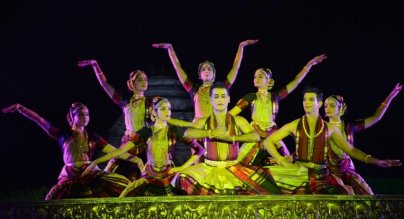 A. Lakshmanaswamy & group 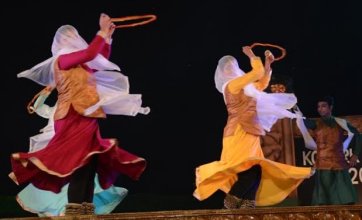 Ashimbandhu Bhattacharjee's group Yet another very well crafted recital of sophisticated artistry was Kathak by Ashimbandhu Bhattacharjee and group. The performance on stage became a metaphor for a journey of life - its cyclical nature stressed symbolically from the very opening wherein the lehra cycle, the cycle of rhythm, the dance chakkars, the circular formations with Ashim himself taking a large round (parikrama) of the stage through chakkars (like concentric cycles) established the circular geometry. The rhythm of life saw tala chakra with intra forms woven into the lehra - with various jatis, tisra, misra, khanda in the teental presentation, with a navarasa fleeting glimpse also in khandajati. The lila of Krishna within nine minutes visualized telling glimpses of the butter stealer, the destroyer of Pootana and Kaliyamardhan to a tigda tigtig thai, with ginti tihai, a whole rhythmic exchange, with the Guru executing a nritta piece with 21 chakkars as finale. The way formations were made and dissolved made for visual satisfaction and all the stylish dancers were turned out in matching superb get-up. Soorya Parikrama saw Dhamar vivacity through the male dancers though unfortunately the non-functioning foot mikes made the Guru's footwork inaudible. The final Ananda after war in the healing power of the Jhaptal Tarana, was followed by the tatkar crescendo. Kabi Samrat Upendra Bhanja's Lavanyabati became the theme of GKCM Odissi Research Centre, conceived by Dr. Sangita Gosain with Prof Nandakishore Misra's text and choreography, with music by Sukant Kumar Kundu assisted by Swapneswar Chakraborty, the rhythmic inputs being by Sachidananda Das. Beautiful Banchbati, as per the curse of Bana Devi dies when she is made love to by a mere mortal Pravakar who as per the oracle drowns himself in the ocean, for Panchbati to be reborn as Lavanyabati marrying Pravakar reborn as the Singhala prince Chandrabhanu. The strong team of musicians were all from the Research Centre and while the dancers (barring a couple), all disciples of Nabakishore Misra of the Culture University, performed with finesse, the Research Centre which seems to have done little in the dance department for some time, has now to be revitalized bringing out students under its new head Sangita Gosain. The choreography had Pala and Daskatia bits woven into the dance narrative - very efficiently executed by the performers. 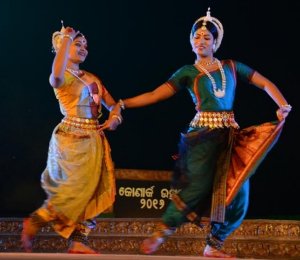 GKCM group 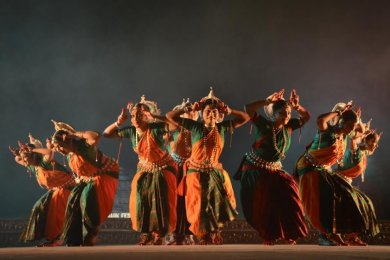 Pitambar Biswal's group A last minute inclusion "Suravi" by Pitambar Biswal, a disciple of Durgacharan Ranbir of the Debaprasad school of Odissi, and his group, perhaps due to lack of rehearsing time, could not live up to its full potential in the Odissi segment. Surya Upasana, a creation of Guru Durgacharan Ranbir had strong group images - the dance built round stances punctuating minimal nritta segments. Against the Sun temple, the presentation had a strong sense of immediacy. The Geeta Govinda dance drama was a mixed affair, Archita Panda (whose beauty queen and cinema star attributes were faithfully touted by the two comperes!) has the height and grace for playing Krishna, though she needs more of 'lavanya' and a primary need to lose her sense of self in the dance - which she could not in Lalita Lavangalata. In the Yahi Madhava scene, she seemed to get frozen into one expression of worry. She was convincing in Priye Charusheele, specially in the "dehi pada pallavamudaram" bit. The dancer who played Radha was excellently communicative and so was the sakhi in the Ashtapadi Rati sukhasare. Dheera sameere Yamuna teere was sung with great intensity by the vocalist and the percussion passages on Khol were very evocative. Priti Patel's Manipuri group provided the perfect ending, the Anantashakti-Leishem Kanglou theme portraying the cosmic play of creation, preservation and destruction, breathtaking in the discipline and artistry of knitting other traditions with bits of classical Manipuri. If the ritualistic dances of Lai Haraoba with the dance of creation and the spirit of that energy moving the Cosmos showed the beginning, the power of martial art Thang Ta with swords symbolised the destructive force, and finally came the Rasleela bits where the eternal lila of the jeevatma looking for its cosmic identity is symbolised through the Krishna Gopi love and devotion. In weaving several aspects into an artistic whole, Priti Patel's creative abilities are limitless. 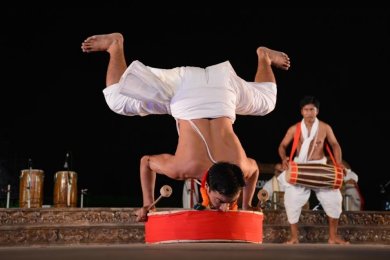
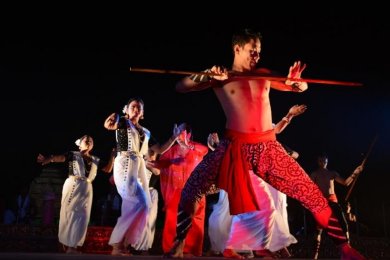
Priti Patel's group
In no government festival is so much of detailed thanks giving to every person with the smallest contribution, a feature. The two aspects which need tightening were the brochure which needed greater care in editing and the Doordarshan coverage which seemed to make performances which were most admired (and there were some very discerning viewers amongst the audience), look very unpromising in the camera work - colours looked over loud and the entirety got lost in broken images. It seemed that an inexperienced person was behind the camera - for this requires specialised expertise.  Writing on the dance scene for the last forty years, Leela Venkataraman's incisive comments on performances of all dance forms, participation in dance discussions both in India and abroad, and as a regular contributor to Hindu Friday Review, journals like Sruti and Nartanam, makes her voice respected for its balanced critiquing. She is the author of several books like Indian Classical dance: Tradition in Transition, Classical Dance in India and Indian Classical dance: The Renaissance and Beyond. Post your comments Please provide your name and email id when you use the Anonymous profile in the blog to post a comment. All appropriate comments posted with name & email id in the blog will also be featured in the site. |